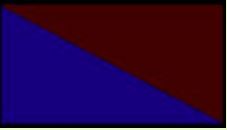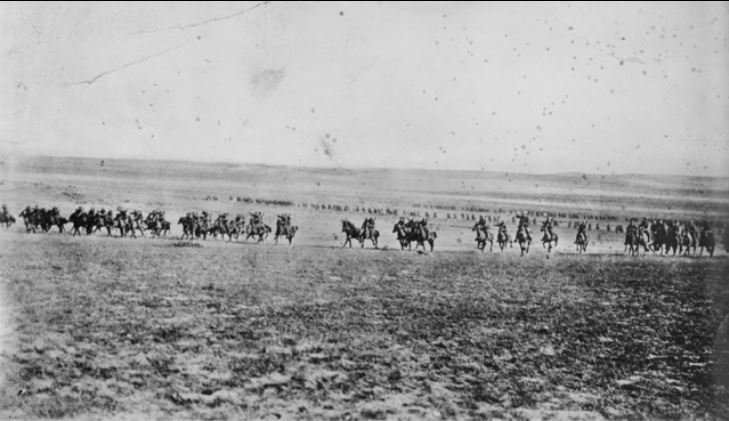4th Light Horse Brigade Field Ambulance
From Our Contribution
 Shoulder patch | |
 Beersheba charge, or February 1918 re-enactment? | |
Contents
Brief History
In January 1917, it was decided to split the Australian and New Zealand Mounted Division (Anzac MD) into two division, the new Anzac Mounted Division and a new division called the Imperial Mounted Division. One new Australian Light Horse Brigade was formed from the existing Camel Regiments which was re-named the 4th Light Horse Brigade. Part of the process was the creation of a specific Field Ambulance unit to service the immediate medical requirements of the Brigade. As no such unit existed, by necessity, the staffing had to come from experienced members of other Field Ambulance and Hospital formations.
To minimalise the impact of stripping down other formation, each unit in the AIF based in Egypt was asked to contribute personnel. The following is the detail contained in the letter:
- 1st LHFA - 5 Other Ranks
- 2nd LHFA - 5 Other Ranks
- 3rd LHFA - 5 Other Ranks
- 2nd Australian Stationary Hospital - 5 Other Ranks
- 14th Australian General Hospital - 6 Other Ranks
- 12 x Light Horse Regiments (1 man from each Regiment) - 12 Other Ranks
- 3 x Machine Gun Squadrons (1 man from each Squadron) - 3 Other Ranks
- Field Squadron - 1 Other Rank
- Signal Squadron - 1 Other Rank
- Divisional Headquarters - 1 Other Rank
- Training Camp, Moascar - 6 Other Ranks
- 4th Camel Regiment - 1 Other Rank
- 7th Sanitary Section - 8 Other Ranks
Total Composition of the 4th LHFA = 59 Other Ranks. The process of assembling the 4th LHFA was finalised by early February 1917.
The Field Ambulance was engaged in the attack on Beersheba"The attack was launched at 1900 and it was only a matter of minutes before Beersheba was entirely in our hands.Casualties Arrive
Casualties commenced to arrive at 2100. The bearers and sand carts travelled backward and forwards between the battle-field and Dressing Station till 0400 November 1. Forty-six Australian patients were treated and as most of the wounds were severe, the dressing staff was kept working continuously without any respite. When all patients had been dressed and fed, most of the staff went to bed. At 0600, however, hostile aircraft bombed the Station but no damage was done.
As soon as the Receiving Stations received the news of the fall of Beersheba, they left Asluj for the captured town in accordance with pre-arranged plans. Here they occupied the Turkish Hospital which was in a dirty condition and infested with vermin. This building was considered unsuitable for the reception of patients, so with as little delay as possible, the Station established itself in the Town Hall. At 1100 on November 1 the patients at Khashim Zanna were evacuated to the Australian Receiving Station at Beersheba and five men who had died of wounds in the Ambulance were conveyed by cacolet camels to Beersheba for interment in the Military Cemetery there.
Ambulance's First Casualties
Having cleared the Dressing Station of patients, the Ambulance moved on to Beersheba and occupied a camp-site in the Brigade area to the East of the town. The horses were watered and tents pitched. Just as the animals returned from water, the attention [8] of the men of the unit was attracted by the MG Squadron opening up fire. On looking skywards an enemy plane, flying very low, was seen approaching the Ambulance. All dived to the ground for shelter but it was then too late. The enemy had dropped his bomb in the midst of the bearer lines. The thunderous explosion was followed by an appalling spectacle. The horse lines were strewn with the intestines of eviscerated animals, and in the midst of this scene were lying many of our own personnel. Some had their limbs shattered, whilst others had their chest and abdomen torn away. Here and there were horses limping away on three legs. The scene was simply indescribable. The casualties were four killed and eight wounded, whilst 14 animals were also killed or had to be destroyed. These were the first casualties that were suffered since the inception of the Ambulance. The deceased soldiers were all buried in a gum tree plantation which was set apart from the Military Cemetery."[1]
Four other men posted to this unit lost their lives, three to disease and one to an accident.
Unit Personnel
- Harold Stinton 23 May - 7 Sep 1918
Patients
- Edward Augustus Davis 25 Aug - 13 Sep 1917
- John Henry Hart 24 May 1919 - 28 Jun 1919
- Spencer Gwynne DCM MID 2 Sep 1918
Individual Honours
Notes
- ↑ The Battle of Beersheba, Palestine, 31 October 1917, 4th LHFA, AIF, Unit History Account accessed 7th March 1921